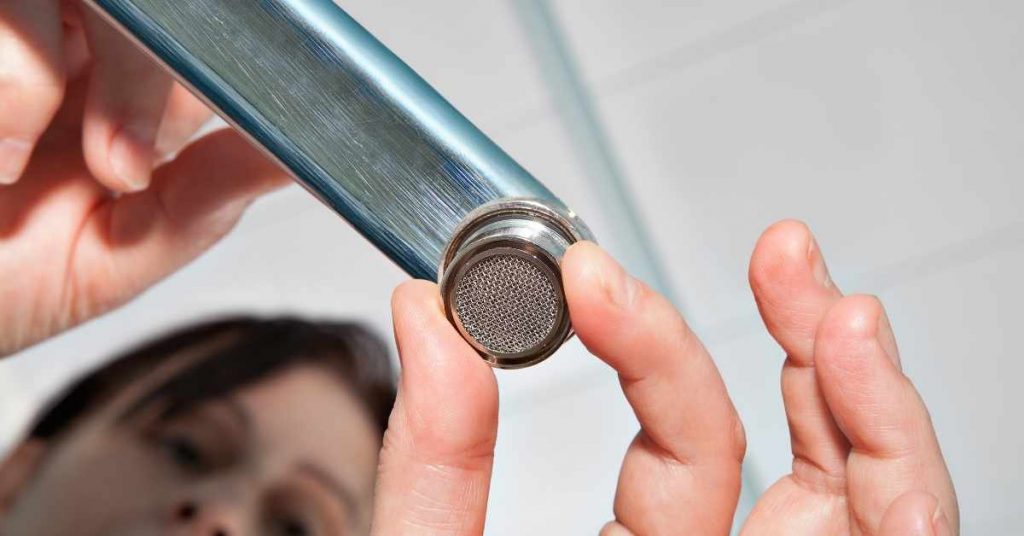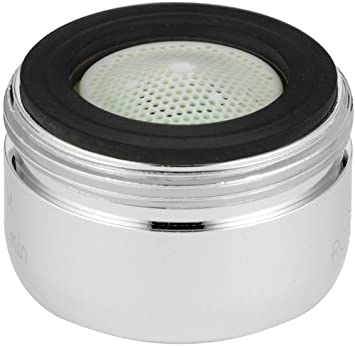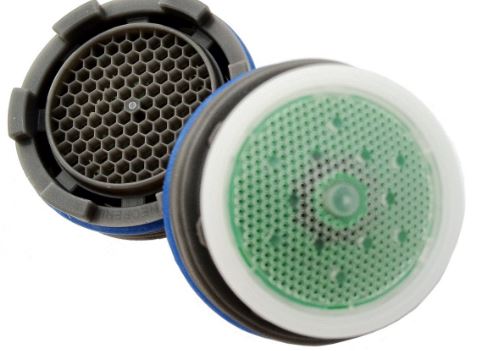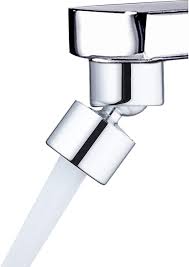
What Faucet Aerators Do
Faucet aerators are small devices attached to the tip of a faucet’s spout. Their primary functions are to:
- Introduce air into the water stream, creating a mixture of water and air bubbles.
- Reduce water flow, conserving water and energy.
- Prevent splashing and create a smoother, more controlled water flow.
- Improve water pressure, especially in homes with low water pressure.
Sizes of Faucet Aerators
Faucet aerators come in various sizes, usually measured in gallons per minute (GPM). Common sizes include:
- 1.0 GPM: Ultra-low flow aerators, ideal for maximum water conservation.
- 1.5 GPM: Low flow aerators that balance water conservation with adequate flow.
- 2.0 GPM: Standard flow aerators suitable for most household tasks.
- 2.5 GPM: High flow aerators, useful for filling large containers quickly.
Types of Faucet Aerators
There are different types of faucet aerators to suit various applications:
- Regular aerator: The standard type, suitable for most sinks.
- Swivel aerator: Can be rotated to direct water where needed.
- Spray aerator: Provides a shower-like spray pattern for rinsing.
- Bubble stream aerator: Creates a uniform, bubbly water stream.
- Dual-flow aerator: Allows users to switch between aerated flow and a steady stream.
Replacement of Faucet Aerators
To replace a faucet aerator, follow these steps:
- Turn off the water supply to the faucet.
- Remove the existing aerator by twisting it counterclockwise with pliers or by hand.
- Clean the threads on the faucet spout.
- Apply plumber’s tape (Teflon tape) to the threads of the new aerator.
- Screw the new aerator onto the spout by turning it clockwise until snug. Be careful not to overtighten.
- Turn the water supply back on and check for leaks.
- Test the new aerator to ensure proper water flow and pressure.
What Do They Do?

When water is flowing inside the pipes and into the faucet, it does so as one stream. When it hits the aerator, it is broken into many thin streams, which introduces oxygen into the water.
As a matter of fact, the word aerator comes from the word aerate, which simply means to introduce air (into something). A faucet aerator therefore allows the introduction of air into the water.
But what is the big deal with introducing air into the water?
Remember that as the water flows into the faucet aerator, the surface area is reduced meaning the flow rate of the water is reduced as well. In this case, the faucet aerator helps you in water conservation, which will be reflected in your water bills.
Flow rate and pressure are however not the same thing. Faucet aerators do not reduce your water pressure, but its flow rate. Water pressure is measured in pounds per square inch (psi) while the flow rate is measured in gallons per minute (GPM).
The injection of air into the water reduces the flow rate but the pressure is not affected. Since the pressure of the water is not reduced in any way, you will not notice the difference in the volume of water coming out of the faucet despite the flow rate being substantially reduced.
Faucet aerators have a rating of between 1.5 to 2.5 gallons per minute. If you want to save more water (especially if you have young kids), consider installing a faucet aerator with a flow restrictor as well.
A flow restrictor is a small plastic disc with a hole in the middle that is installed inside the aerator. It reduces its internal diameter which in returns reduces its flow rate.
Installing an aerator on a faucet also reduces the splash-back of water on the sink. Trying removing you faucet aerator and see how much the water splashes back at you.
Faucet aerators have also been proven to improve the taste of water. Apart from that, the water feels softer to the touch compared with water from faucets without aerators.
How Do I Know Which One to Use?
All faucet aerators are not the same. They differ based on size, the type of threads they have, style and even design. Faucet aerators also have different stream types and flow rates depending on their intended use.
Let us first start by looking at the types of faucet aerators.
What are the Types
There are 2 types of faucet aerators depending on the kind of threads they have. These are female and male aerators.
If an aerator has threads on the outside then that is a male aerator. The faucet spout on which it will be connected to will have internal threads making it a female spout.

If an aerator has internal threads it is known as a female aerator. Female aerators are installed on male faucet spouts, which have threads on the outside.
There are also dual faucet aerators. These types of threads have both the female and male threads, usually separated by a split washer inside the aerator.
There are also 2 types of faucet aerators depending on how they are installed. These are standard aerators and cache aerators, which are also known as recessed aerators.

Standard aerators are clearly visible since they extend from the faucet spout. Cache aerators are hidden inside the faucet and are found in modern high-end faucets.
There are 2 other types of faucet aerators depending on functionality. These are stationary and swivel faucet aerators.
Stationary faucet aerators are the most common and basic type of aerators. They are screw at the tip of the faucet spout and do not move. As their name implies, they are always stationary. The water from these aerators is non-splashing, white, large, and soft to the touch.

A swivel faucet aerator allows you to direct the water in different directions by pulling or retracting it. These aerators are found in modern faucets and may even have dual-stream functionality.
The last type of faucet aerators is the diverter-style aerators. These aerators have a small outlet on the side (diverter) for attaching a hose. This allows you to divert water to a filter while still enjoying the convenience of an aerator.
The Sizes
As I had mentioned earlier, faucet aerators are all not universal. You will first need to determine the size of your old aerator before replacing it.
Let us start with standard faucet aerators.
There are 3 sizes of standard faucet aerators. To determine what size you have, you will need a quarter, a nickel and a dime. Remove the faucet aerator and compare it with the 3 coins by placing the coin on top of the aerator.
- If your aerator is the size of a quarter, you will need a regular-size aerator.
- For an aerator similar in size to a nickel, you will need a junior-size aerator.
- If the aerator is the size of a dime, you will need a Tom Thumb-size aerator.
With cache aerators, the process of determining the size is the same. You will only need a 4th coin. A penny!
- If the aerator is the same size as a quarter, you will need a standard aerator.
- For an aerator same in size as a nickel, you will need a junior-size aerator.
- If it is the same size as a penny, you will need a tiny junior-size aerator.
- Again, for an aerator similar in size to a penny you will need a Tom Thumb-size aerator.
What Flow Rate Do You Need?
After choosing the correct type and size of your faucet’s aerator, you will then need to choose an aerator with a suitable flow rate. The choice of flow water will depend on what the faucet is used for.
Usually, kitchen faucet sinks needs a higher flow rate than bathroom sink faucets. For a bathroom sink you can choose an aerator with a GPM of 1.5 or lower while a 2.2 to 2.5 GPM aerator is ideal for most kitchen faucets.
Type of Water Stream
There are 3 types of water streams that come out of different faucet aerators. Let us look at them briefly.
1. Aerated stream
These aerators introduce air into the water to produce a wider and whiter water stream that is soft to the touch and non-splashing as well. They are the most widely used faucet aerators.
2. Laminar stream
Lamina flow aerators will give out 100% water (non-aerated) and non-splashing as well and are usually installed in places where high flow water application is in high demand.
3. Spray stream
Spray aerators are designed to produce miniature shower patterns (usually when the flow rate is too low to produce aerated or lamina pattern) and provide wide coverage which makes them ideal for hand washing in public restrooms.
How to Replace a them
- Plug off the sink drain to prevent loosing anything to the drain.
- Grab the aerator with your bare hand and try to turn it counterclockwise to loosen it. Some aerators are only hand tight.
- If the aerator is however too tight, you will need a wrench or pliers to loosen it. Grab it with the wrench and gently loosen it.
Note: For a cache aerator you will need a special tool to remove it. This tool is size-dependent and will come with the new aerator.
- Throw the old aerator in the trash bin.
- Flush the faucet spout. To remove the debris still left inside the faucet, turn on the faucet to full blast for a few seconds.
- Screw the new aerator on the spout slowly to avoid cross-threading.
- When it is hand tight, use the wrench or pliers to tighten it. To prevent scratching off the finish from the aerator, wrap a small towel or duct tape around it while tightening.
If you are replacing a cache aerator, you will need to tighten it with the removal tool as well.
How to Clean a them

If you notice that the water pressure in your kitchen faucet has reduced or the stream pattern has changed, the aerator may be corroded. Instead of going ahead and replacing it you can opt to first try clean it.
- Remove the aerator and take it apart
- Drop the pieces inside a bowl of white vinegar. The vinegar will dissolve all the mineral deposits especially calcium which is notorious for clogging faucets.
- Wait for an hour.
- Meanwhile, use a rag to clean the inside of the spout. Dip the rag in the vinegar as well and push it inside the spout with a screwdriver.
- Use an old toothbrush to clean the aerator especially the screen and rinse it with clean water from the faucet.
- Assemble the aerator and install it back.
- Turn on the water full blast and check if the water pressure is sufficient.
And that is pretty much everything I had to say about faucet aerators. I hope you enjoyed this post.
